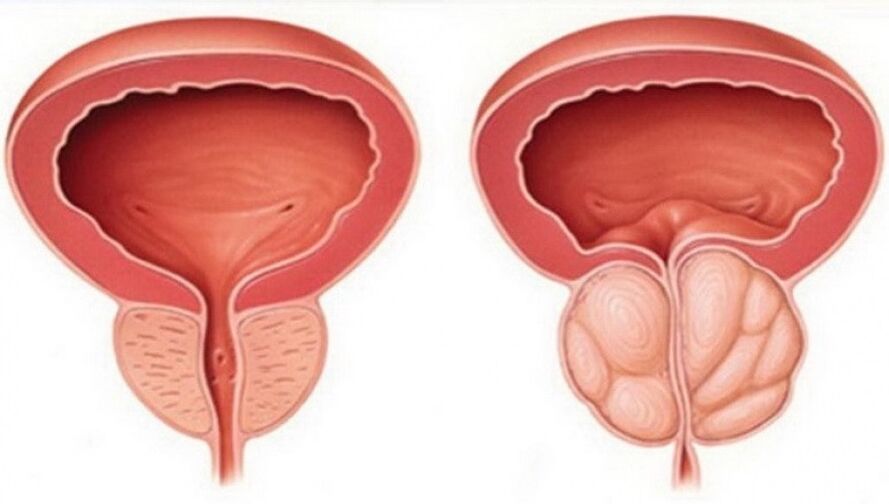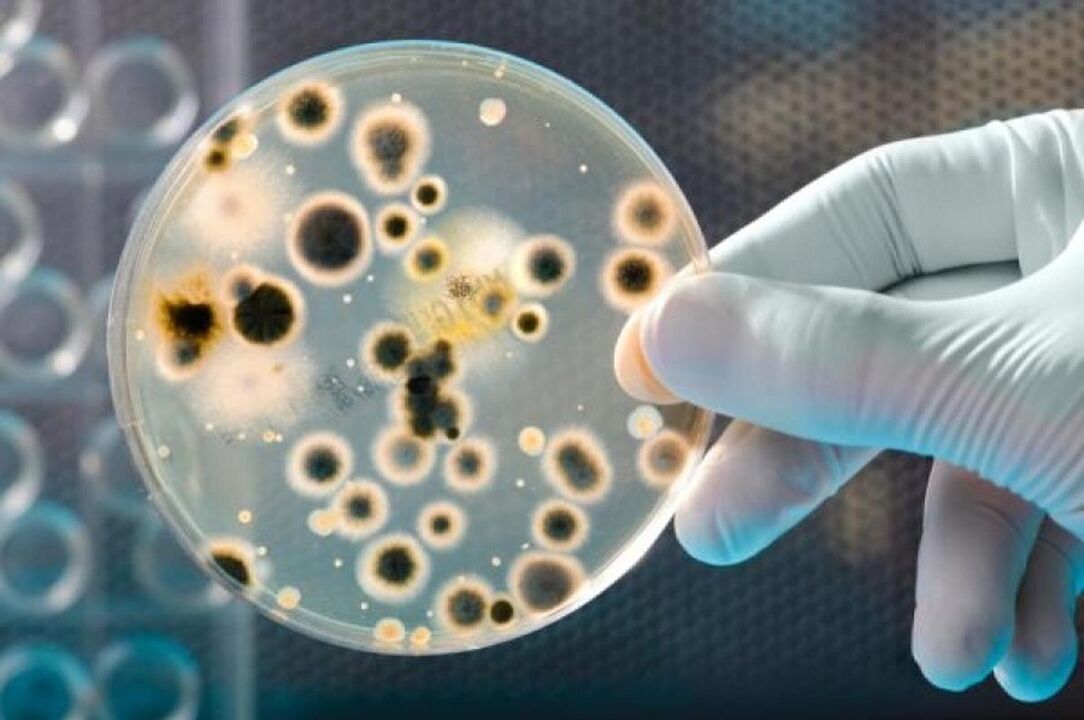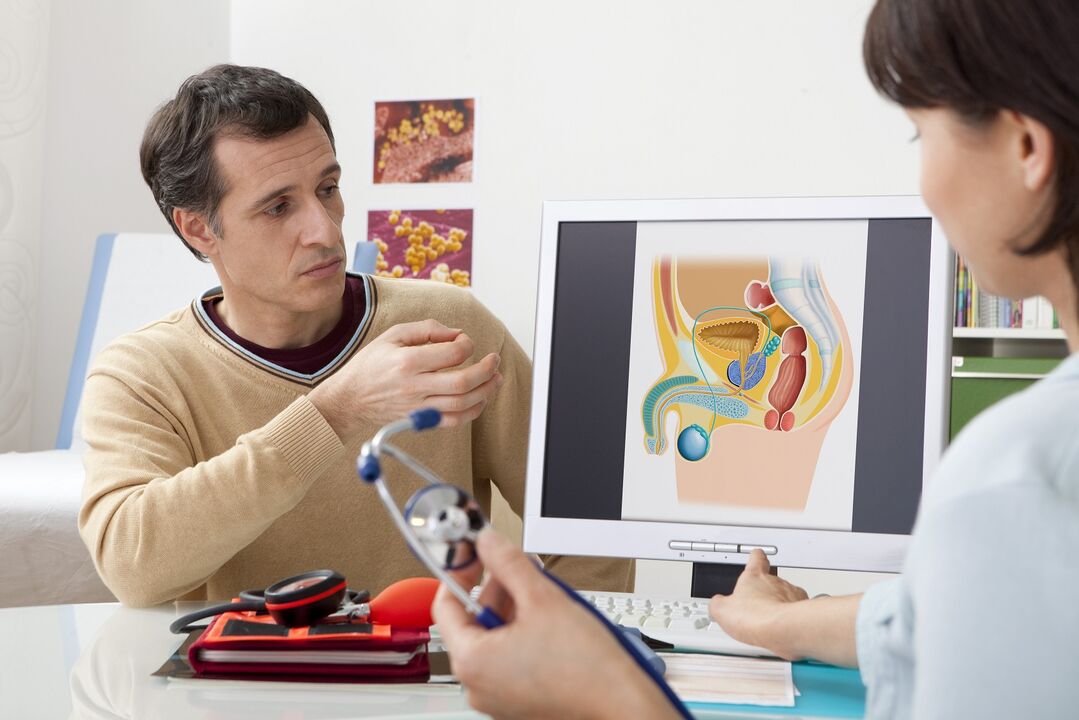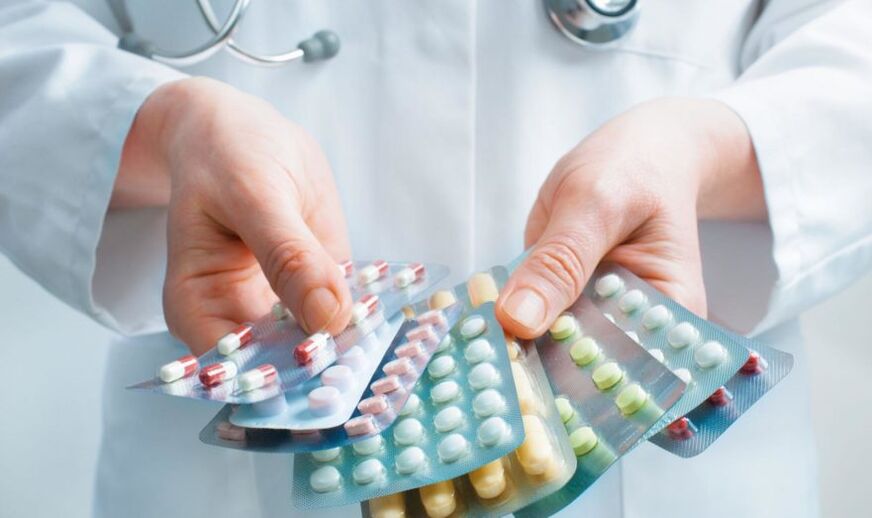According to BME, prostatitis is an inflammatory process that occurs in the prostate gland in men with damage to the parenchyma and interstitium. Treatment of prostatitis in men is a long and difficult event, most often due to complete ignorance of the disease at first. What is prostatitis, what are their causes and early signs, what you need to know about the topic of "diagnosis" and what modern methods of treating prostatitis exist. All men need to know about prostatitis in this review article.

Ab ovo - from the egg
We are not talking about Horace's satyrs, in this case we are interested in everything related to prostatitis, from the beginning to the last "squeak" of the treatment. Symptoms of prostatitis are found in men during the period of active sexual activity, from 25 to 45 years old, on a thematic video you can study in detail everything related to the fundamentals of the disease, its causes and symptoms, the peculiarities of the diagnosis and treatment.
The reasons for the development of prostatitis are extensive. With prostatitis, infectious factors have the greatest weight in the development of the disease:
- Acute form. The coccal flora acts as provocative reasons.
- Chronic form. The reasons for its development are more extensive, since the primary factors of such prostatitis in men are: gonococci, Trichomonas, Gr + and Gr-bacteria, mycobacterium tuberculosis. In rare cases, the diagnosis reveals mycoplasma, viruses, fungi, chlamydia, etc.
It is noteworthy that chronic prostatitis, caused by a pathogen that has penetrated the prostate gland, can subsequently have a pathogenic factor and be bacterial in nature. The acute form is most often provoked by external causes: hypothermia, trauma to the urethra or damage to the bladder as a result of endoscopic examinations or various manipulations, hypodynamy and, as a result, violation of blood and lymphatic circulation in the pelvis (congestive prostatitis), disorders hormonal or autoimmune.

Often you can hear about only one type of prostatitis - infectious, however, according to the WHO, bacterial prostatitis accounts for no more than 10% of all cases of the disease, while chronic abacterial prostatitis is recorded in 90% of cases.
Table no. 1. Brief characteristics of the pathology
| Categories for prostatitis | Acute infection | The presence of the pathogen in the secret of the prostate or in the 3rd portion of urine | The level (increase) of leukocytes with m / s secretion or urine |
| 1 cat. acute bacterial | + | + | + |
| 2 cat. chronic bacterial | - | + | Uncertain (whether or not) |
| 3 bis. Chronic pelvic pain syndrome of an inflammatory, non-bacterial nature | - | - | + |
| 3 b. Prostadynia, non-inflammatory pelvic pain syndrome | - | - | - |
| 4 cat. Asymptomatic inflammatory process | - | Uncertain (yes or no) | Uncertain (yes or no) |
The etiology of bacterial prostatitis in acute and chronic manifestations has been studied more thoroughly, in most cases the bacteria of the family become the cause of the disease. Enterobacteriaceae (E. coli bacillus). The role of atypical microorganisms as a cause of prostatitis (ureplasma, chlamydia, mycoplasma) is currently considered not fully proven. Symptoms of prostatitis in men with signs of weakened immunity, particularly with HIV, can be caused by yeast (Candida spp. ) Or tuberculous mycobacterium.
Before the advent of the era of antibiotics, gonococcal flora (Neisseria gonorrhoeae) played a significant role in the development of prostatitis, especially often it became the cause of its abscess form.
The causes of the abacterial form of prostatitis have not been fully studied, although urologists have thoroughly studied the list of possible pathogenetic factors (provoking prostatitis) that play an important role in the onset of inflammation in the prostate without the presence of microorganisms. Thus, at the heart of the causes of non-bacterial prostatitis are stagnant processes in the small pelvis, circulatory disturbances, intraprostatic reflux of urine and an autoimmune aseptic inflammatory process.
Sick or not - this is the dilemma
What does a man with prostatitis look like? For a person distant from medicine, and even more not an expert in the problems of urology, the male aspect of an individual is no different from the crowd of others. And only an experienced specialist, from the first complaints of the patient, will understand where the root of the problem has matured and what ways to eliminate it will have to go.

Symptoms of prostatitis are often described in several sentences, highlighting the brightest moments, and this makes a cruel joke with a man. Based on such imprecise definitions, he ignores really important bells, believing that the disease does not exist, although in reality the clinical picture depends on the nature of the morphological changes in the prostate.
The first symptoms can be attributed to the following types of prostatitis:
- Catarrhal prostatitis. Dull pain in the perineum, radiating to the sacrum, frequent nocturnal impulses.
- Follicular prostatitis. Difficulty and frequent urination, sometimes with delay. Pain during "peeing", aggravated at the end of the urination process, as well as bowel movements. Low fever.
- Parenchymal prostatitis. There are symptoms of pronounced dysuria, often AUR, pain during natural recovery, general intoxication with a temperature up to 40 C.
In case of prostatitis with abscess formation, the symptoms are brighter with the possible opening of the abscess in the rectum or prostatic part of the urethra. With such a turn, the symptoms subside. If the opening of an abscess occurs in the paraprostatic tissue or in the perineal region, visual symptoms can be observed: swelling, redness of the skin with pronounced fluctuation. At the same time, the condition of man drastically worsens.
Complete treatment of prostatitis cannot be started without a thorough examination of the man, diagnosis and analysis of symptoms that can directly indicate the type of disease.
In general, it is customary to distinguish between the acute and chronic course of prostatitis; on a thematic video on the Internet, you can find out in detail which symptoms refer to one form or another. Let's consider this problem in more detail.
Acute - its typical symptoms are characterized by the manifestation of three stages: catarrhal, follicular and parenchymal. They are described in detail above.

The most interesting in terms of symptoms is the chronic form of prostatitis, as there are many variations in the symptoms. In general, the effective treatment of prostatitis depends on prostatitis, or rather on its type.
In the chronization phase, the following moments can be distinguished:
- Chronic prostatitis is rarely the result of an acute process.
- Primary prostatitis disappears with the cancellation of symptoms.
- A characteristic symptom of chronicity is poor discharge from the urethra during bowel movements.
- The first symptoms, as a rule, are not expressed, the pathological process itself develops over the years. It is preceded by prostatosis (congestion in the capillaries), which smoothly turns into a bacterial form of inflammation of the prostate gland.
- Specific pathogenic microflora is not the cause of chronic prostatitis, but the chronic process itself is a complication of the inflammatory process due to the effects of ureaplasma, Trichomonas, chlamydia and gonococcus.
How does a man feel with chronic prostatitis? Patient reviews show that very often at first slight pains in the perineum are felt, poor discharge, which most men simply do not pay attention to. The next stage is the union of the following symptoms: burning sensation in the urethra, sexual dysuria, general malaise. Frequent misfires during sex make men depressed, irritable, or depressed.
It is important to understand that all these signs do not necessarily appear in each specific case of chronicity, this is what complicates the diagnosis at an early stage of the disease, moreover the symptoms tend to change places, which is even more misleading.
Long-term syndromes
What can you expect from chronic prostatitis? If there is no timely diagnosis and treatment, no good, any specialist will confirm this. This type of prostatitis is characterized by 3 syndromes:
Ache
The prostate itself does not hurt, but many nerve endings pass through it and are nearby, which inevitably get involved in the inflammatory process. The pain can be of different intensity: from a little painful, creating discomfort, to severe, not allowing you to sleep peacefully. Irradiation of pain occurs in all nearby areas (scrotum, sacrum, perineum), pain from prostatitis must be differentiated from similar symptoms of other diseases.

Dysuria
Dysuric syndrome always indicates a malfunction of the urinary system, but what caused it is revealed during the diagnosis. The increase in the volume of the prostate inevitably compresses the urethra and the flow of urine is interrupted, followed by the development of a frequent need to use the toilet, a feeling of incomplete emptying of the bladder. With advanced prostatitis, there is compensatory hypertrophy of the muscular layer of the bladder and ureters. At this time, the symptoms of dysuria subside, but return again in an intensified form.
Sex without pleasure
A declining intimate life - these are the first symptoms men notice, and it is they, as reviews show, that force them to see a doctor. Frequent nocturnal erections, a canceled orgasm, poor erection and rapid ejaculation, pain during this - this is what worries the stronger sex the most. In the advanced stage of chronicity, nothing good can be expected from prostatitis; erectile dysfunction often develops.
The degree of sexual disorder in men is not the same, someone initiates sexual intercourse and somehow completes it, sweeping away the bell features. For some, even the initial feeble response of the penis to a fascinating stimulus becomes a collapse and the onset of disturbing experiences that turn into prolonged depression. The spectrum of impotence is difficult for patients with prostate problems, almost always experts and relatives note that prostatitis spoils the character.
To learn more about the disease, you can study a thematic video, in which experts explain many of the nuances of the pathology.
What to write on the paper
Which record will appear in the patient's medical record and which final diagnosis will be established depends on a series of primary studies, starting with the patient's arrival at the urologist and his complaints (anamnesis) to the last stage of diagnostic measures. What exactly is required depends on the type of prostatitis, its neglect and the patient's consent to specific diagnostic procedures.
In general, the diagnosis consists of:
- anamnesis. The doctor will ask in detail all complaints and symptoms, prerequisites of the disease, etc.
- Urine analysis.
- Prostate massage (digital rectal exam + secretion collection).
- Ultrasound of the prostate.
- Spermograms.
- Prostate biopsy (if indicated).
What does diagnostics offer and is it so important? If you read the reviews of patients, you can often understand that most men are trying to evade many stages of the diagnosis, while the reasons are very different. The price of that indifference is your health! It is important to remember that prostatitis is curable only if it is "caught" in time and the diagnosis is made accurately with the definition of the form of the disease and its cause.
How to stay healthy forever
So, the man understands that he has prostatitis, what awaits him in the future and is it possible to return the lost health? It is important to understand that you will have to get rid of prostatitis 2 times longer than it has developed. In addition, if the pathological process has almost gone beyond the man's attention, then the treatment of prostatitis will take place with the direct participation of him. Whether acute or chronic prostatitis can be cured - yes, if you follow all the recommendations of the doctor, in advanced cases of the chronic form, during treatment, stable remission can be achieved.

The stages of treatment of prostatitis will directly depend on what the doctor ultimately found during the examination, the type of disease, the age of the patient and physical data.
The treatment regimen is always strictly individual, but the following points may be present in it:
- Antibacterial therapy.
- Physiotherapy methods.
- Phytotherapy.
- Appointment of immunocorrectors.
- Urological massage.
- Physiotherapy.
The price of each stage of treatment is different, depending on the total cost of prescribed drugs, additional methods and the clinic. The preventive measures that follow the treatment have an important reason: they prevent the return of the disease. Prevention has a direct and close contact with treatment, the basis of prevention is as important as respecting all the doctor's requests during the course of therapy.
Treatment of the acute form
The period of exacerbation requires taking antibiotics, which are drunk in one course. In the presence of chlamydial infection, drugs of the cephalosporin series are indicated.
The duration of the course is significant, on average, antibiotics are drunk for at least 3-4 weeks to prevent a relapse of the disease. Sometimes the doctor continues the treatment for a longer period, antibiotics are combined with analgesics to relieve pain.
Treatment with antibiotics is carried out taking into account the following rules:
- Bacterial culture is necessary to determine the sensitivity of microorganisms to the drug.
- Side effects and contraindications of drugs are taken into account.
- They take into account the previous course of treatment, when it was, what means were used and the result.
The need for additional methods of treatment is determined by the attending physician, it should be remembered that massage is contraindicated in the acute form of prostatitis, as it provokes the spread of bacterial infection throughout the body, followed by bacteremia and sepsis.

Treatment of the chronic form
It is important to remember that it is impossible to quickly get rid of chronicity, in principle the disease has developed over the years and it is beyond the power of even doctors in their field to destroy it in a couple of weeks, you do not need to take the word of those who have cured the disease in 2-3 days. Treatment is aimed at stopping the focus of infection, restoring immunity in men and the work of the prostate gland, as well as preventing exacerbation - this takes time.
The course of antibiotic therapy lasts from 4 to 12 weeks, with low effectiveness of treatment, the drug continues to be taken. Most often, antibacterial drugs are prescribed in combination with other anti-inflammatory drugs. In advanced cases, surgery involves partial or complete excision of the prostate gland.
Free of bacteria and symptoms
A characteristic difference of therapy is the absence of antibiotics, without the presence of pathogenic microflora, they are simply not needed. But sometimes experts prescribe a short course of medication in 2-4 weeks.
The treatment of abacterial prostatitis is based on the use of physiotherapy methods: iontophoresis, ultrasound, laser therapy, electromagnetic radiation and symptomatic therapy with strengthening of the patient's immune system.
Changes in diet and lifestyle are also the basis of the treatment of non-bacterial prostatitis, baths, alpha-blockers are shown.
Symptom-free prostatitis is difficult to detect; in the diagnosis, the PSA method is used, followed by the appointment of a 2-week course of antibiotics as treatment. Subsequently, individual symptomatic treatment is selected.
In general, the treatment of any type of prostatitis is a long-term phenomenon and not always pleasant for the patient himself. In addition to physical discomfort, a man suffers psychologically, because his most precious part of the body is affected: the intimate one. Reviews of those who have cured the disease show that only strict compliance with the doctor's prescriptions, along with changes in diet and lifestyle, pays off. The price of a frivolous attitude to treatment is very high: a man loses not only health, his whole life, character and relationships with others are changing. To prevent this, it is necessary to monitor the health of the prostate gland and eliminate the causes of the development of diseases.






























